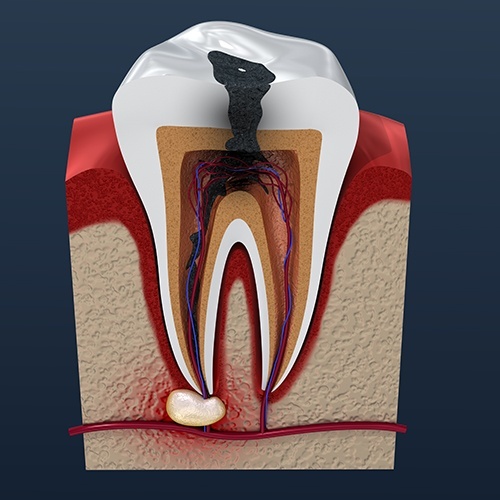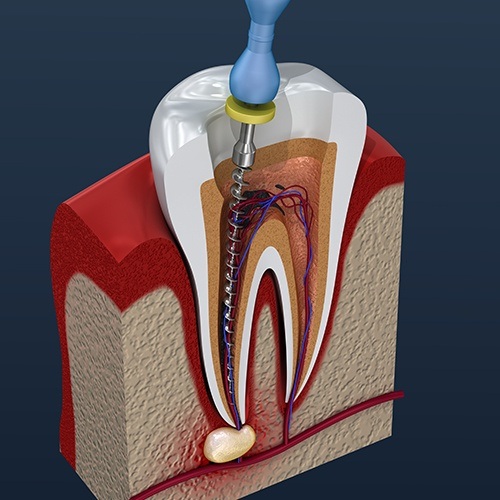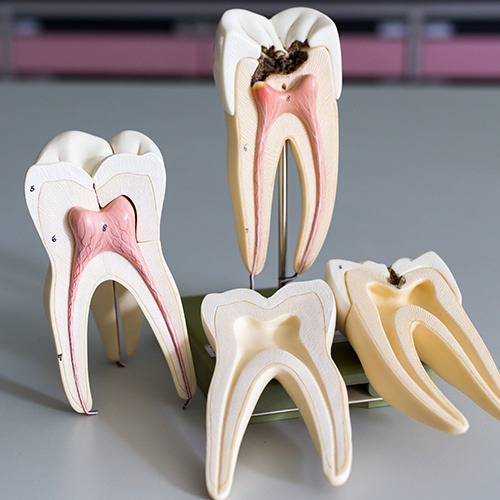Root Canal Treatment – Lacey, WA
Restore the Health of Your
Tooth with a Root Canal
Root canal therapy is necessary when tooth decay has advanced beyond the outer surface of the enamel to infect the pulp. Also known as endodontic treatment, it’s the last step taken before tooth extraction. While root canal treatments have the reputation of being painful, with modern dentistry, chances are good you won’t feel a thing throughout the procedure -- and the treatment is certainly not any worse than the pain of the original toothache. If you need a root canal treatment in Lacey, WA, don’t despair. You’ll soon be on your way to relief.
Why Choose Peterson & Cammack Family & Cosmetic Dentistry for Root Canal Treatment?
- We Accept Dental Insurance
- Treating Patients of All Ages
- Emergency Patients Welcome
Signs You May Need a Root Canal

A root canal is necessary when the pulp (often called the “nerve”) of the tooth becomes infected, so you’ll feel discomfort in the tooth when it needs a root canal. Pain, prolonged sensitivity to heat or cold, tenderness and swelling or drainage are all certainly signs you need to see the dentist -- and probably that a root canal is necessary, too.
Steps of a Root Canal Treatment

The procedure for a root canal may be completed in one visit to your dentist, but if the infection is very severe it will be carried over into two appointments to Peterson & Cammack Dentistry.
The treatment looks something like this.
- After anaesthesia has been administered to ensure you’re completely comfortable, your dentist gains access to the inside of the tooth through a small hole. Infections in the front teeth will be reached through an access hole in the back of the tooth, and those in the back teeth will be entered through the chewing surface.
- Your dentist measures the length of the tooth to help treat just the area of the pulp and root canals and nothing more.
- The tooth is cleaned by removing the dead or infected nerve tissue, and the root canals are shaped to receive the fillings.
- After the tooth is clean and has been shaped, it’s filled in with a biocompatible material (usually the rubber-like material known as gutta-percha). This step may be completed in the same visit, or carried over into another appointment to allow time for the infection to heal. If the latter is your best option, you’ll receive a temporary filling.
- Once your tooth is ready, your dentist places a permanent crown or filling to restore the tooth to its original strength. The root canal is complete.
Special Care After Your Root Canal Treatment

If your tooth is not rebuilt in the same appointment (between steps four and five listed above), take care while eating with your tooth. Stay away from hard, crunchy or sticky foods in general and don’t bite or chew on that side at all.
Once your tooth has been fully restored, you’ll need to keep up with your good oral hygiene habits. These include brushing for two minutes, twice a day, flossing daily and visiting your dentist as recommended for routine checkups and cleanings.
Understanding the Cost of Root Canals

If your dentist has recommended root canal therapy in Lacey, you probably want to know how much it’ll cost before scheduling your procedure. Since every patient’s situation is unique, the total price can vary based on several factors. Our team is here to help you navigate financing options and ensure you get the care you need. Read on to learn more, or call our office today for a personalized estimate!
Factors That Can Affect Root Canal Cost

The exact cost of your root canal can only be determined after a thorough examination of your mouth. Once we assess your condition, we can provide a detailed breakdown of the expenses involved. Some key factors that influence the overall cost include:
- Type of Tooth and Location – Molars, for example, tend to be more complex and costly to treat than front teeth.
- Complexity of Procedure – If a specialist, such as an endodontist, is needed, the cost may be higher.
- Additional Services – Some cases require a dental crown after treatment, adding to the total cost.
Is it Cheaper to Pull My Tooth?

While extracting a tooth may seem like a more budget-friendly option upfront, it can lead to costly long-term consequences. Losing a natural tooth can impact your bite, cause surrounding teeth to shift, and make chewing more difficult.
To restore function and aesthetics, you may need a dental implant or bridge, which can be significantly more expensive than a root canal. Additionally, delaying treatment increases the risk of complications that may require extraction anyway. Saving your natural tooth with a root canal is often the most cost-effective solution in the long run.
Does Dental Insurance Cover Root Canals?

Root canal therapy is generally classified as a major procedure, meaning most dental insurance plans cover between 50-80% of the cost after the deductible is met. However, every policy is different, so it’s important to check with your provider for specific coverage details! Our team is happy to assist with insurance verification and maximizing your benefits to minimize out-of-pocket expenses.
Other Options for Making Root Canal Treatment Affordable

No dental insurance? No worries! We offer third-party financing through Cherry Financing, allowing you to split the cost into manageable monthly payments. Many of these plans come with little-to-no interest, making high-quality dental care more accessible for every budget.
At our practice, we believe financial concerns should never stand in the way of necessary treatment. If you need a root canal, don’t hesitate to reach out – we’ll work with you to find a payment solution that fits your needs.
Root Canal FAQs
Can I Eat Before a Root Canal?
Yes, in most cases, you can eat before a root canal. In fact, eating a light meal a few hours before your appointment is recommended because your mouth will stay numb for a few hours after your appointment. This makes it somewhat risky to eat because you could bite your lips, cheek, or tongue and not know it.
So, eat something that is room temperature, easily chewed, and doesn’t leave a lot of particles behind. With your meal, be sure to drink plenty of water to stay hydrated ahead of your procedure.
How Long Does a Root Canal Take?
A root canal typically takes 60 to 90 minutes per tooth. In many cases, it can be completed in just one visit! However, if the infection is severe or if additional work, like placing a crown, is needed, you may require a second appointment. At Peterson & Cammack Family & Cosmetic Dentistry, we use advanced techniques to make the process as efficient and comfortable as possible. While it may seem like a long procedure, the time spent ensures your tooth is saved and future pain is prevented.
What Happens if You Wait Too Long for a Root Canal?
Delaying a needed root canal can lead to serious complications, so it’s always best to address the issues as soon as you can. This is because the infection inside your tooth can spread to surrounding tissues, causing:
- Increased pain and swelling
- Abscess formation, which may require emergency treatment
- Bone loss around the affected tooth
- A higher chance of tooth extraction
At our Lacey dental office, we recommend root canals to prevent unnecessary discomfort and the need for complex treatments. If you’ve been advised to get a root canal, don’t wait—your health depends on it!
Do Root Canals Ever Have to Be Redone?
Unfortunately, yes, but it’s a very rare occurrence. Root canals have a high success rate, but that doesn’t mean the odds of needing retreatment are zero. Sometimes retreatment is necessary due to:
- Your tooth not being fully cleaned or sealed properly
- A new infection developing due to deep decay or a cracked filling
- A previously unnoticed canal needs treatment
At Peterson & Cammack Family & Cosmetic Dentistry, we use digital imaging and precise techniques to minimize the chances of retreatment. However, if a root canal does fail, we’ll act quickly to restore your oral health.